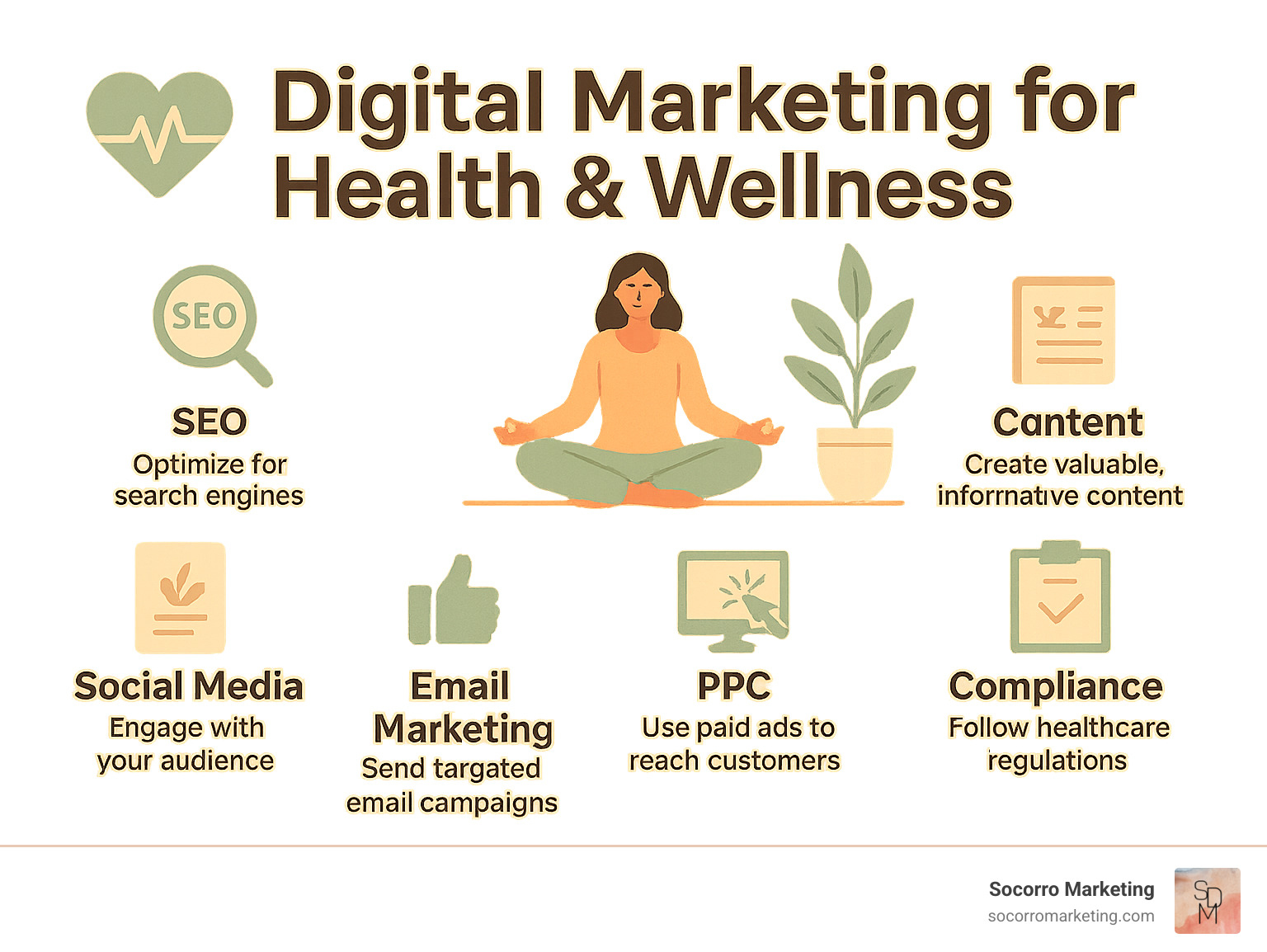Digital marketing for health and wellness is now a must-have as more patients turn to the internet for health information, researching providers, and booking appointments. With 77% of people searching for information during their patient journey and health-related searches making up 5% of all daily Google searches (about 300,000 searches every minute), healthcare businesses can't afford to ignore their digital presence.
Key digital marketing strategies for health and wellness businesses include:
The digital health market reached $452.79 billion in 2023 and is projected to exceed $1.96 trillion by 2030. This growth shows a major shift in how patients find, evaluate, and choose healthcare providers.
Unlike standard marketing, health and wellness digital marketing requires specialized knowledge of medical regulations, patient privacy laws, and the unique trust-building needs of healthcare consumers. Healthcare companies using personalized content strategies see 30% higher patient retention and 15% lower patient churn.
I'm Grace Ascione, a registered nurse with an MBA who has spent 15 years helping healthcare businesses steer digital marketing for health and wellness by combining clinical background with Google-certified expertise. My experience covers both B2B and B2C healthcare marketing, with a focus on helping small practices optimize their online presence to connect with more patients.
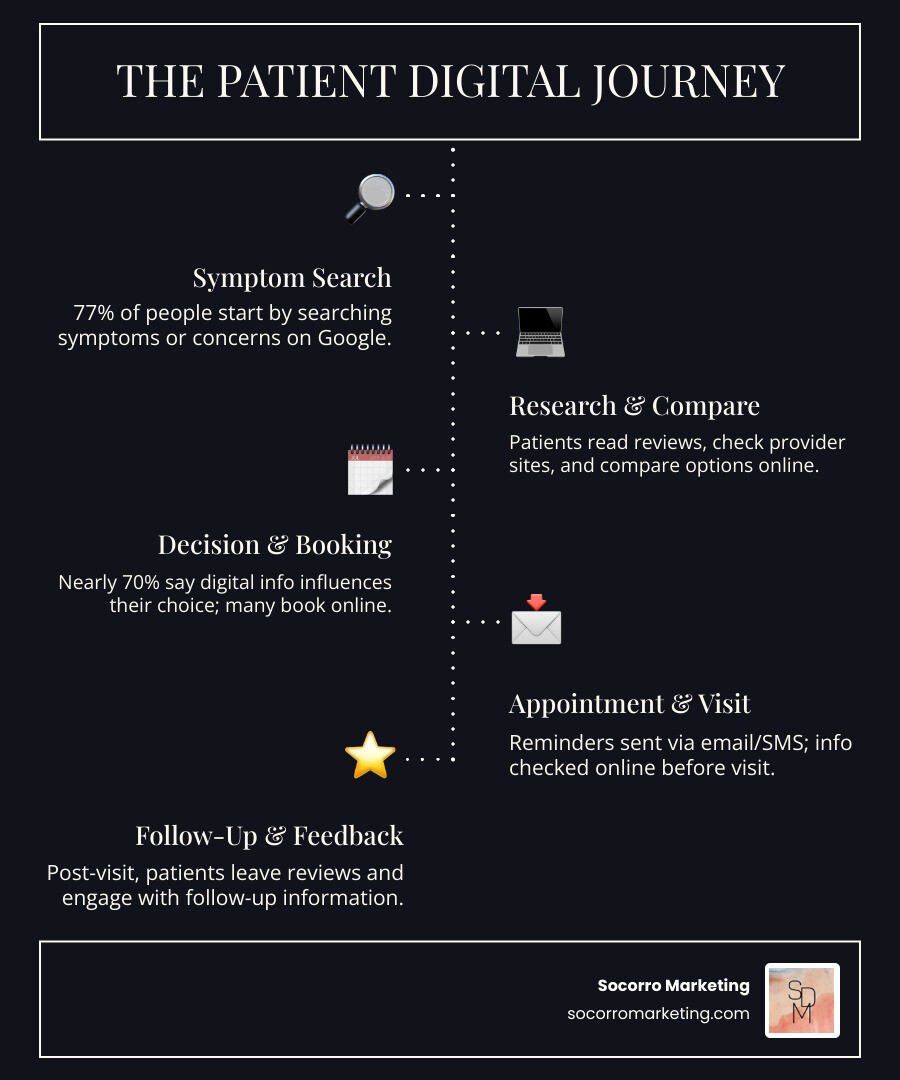
Let’s be honest: “Dr. Google” has become the world’s busiest doctor’s office. Digital marketing for health and wellness isn’t just a nice-to-have anymore—it’s essential for any practice or wellness brand hoping to reach today’s patients. Did you know over half of adults (59%) go online first for health information? And almost 70% of patients say what they find online helps shape their healthcare choices. So, it’s not just about showing up in search results—it’s about being trusted, accurate, and easy for everyone to find and understand.
Patients are doing their homework before reaching out. Every minute, there are about 300,000 health-related searches on Google. People are 2.7× more likely to consider a provider with a strong, up-to-date Google Business Profile, and 55% of folks read doctor reviews before making a decision. Simply put, your online presence is now your first impression.
You can take a deeper look at these trends in this research on online health info.
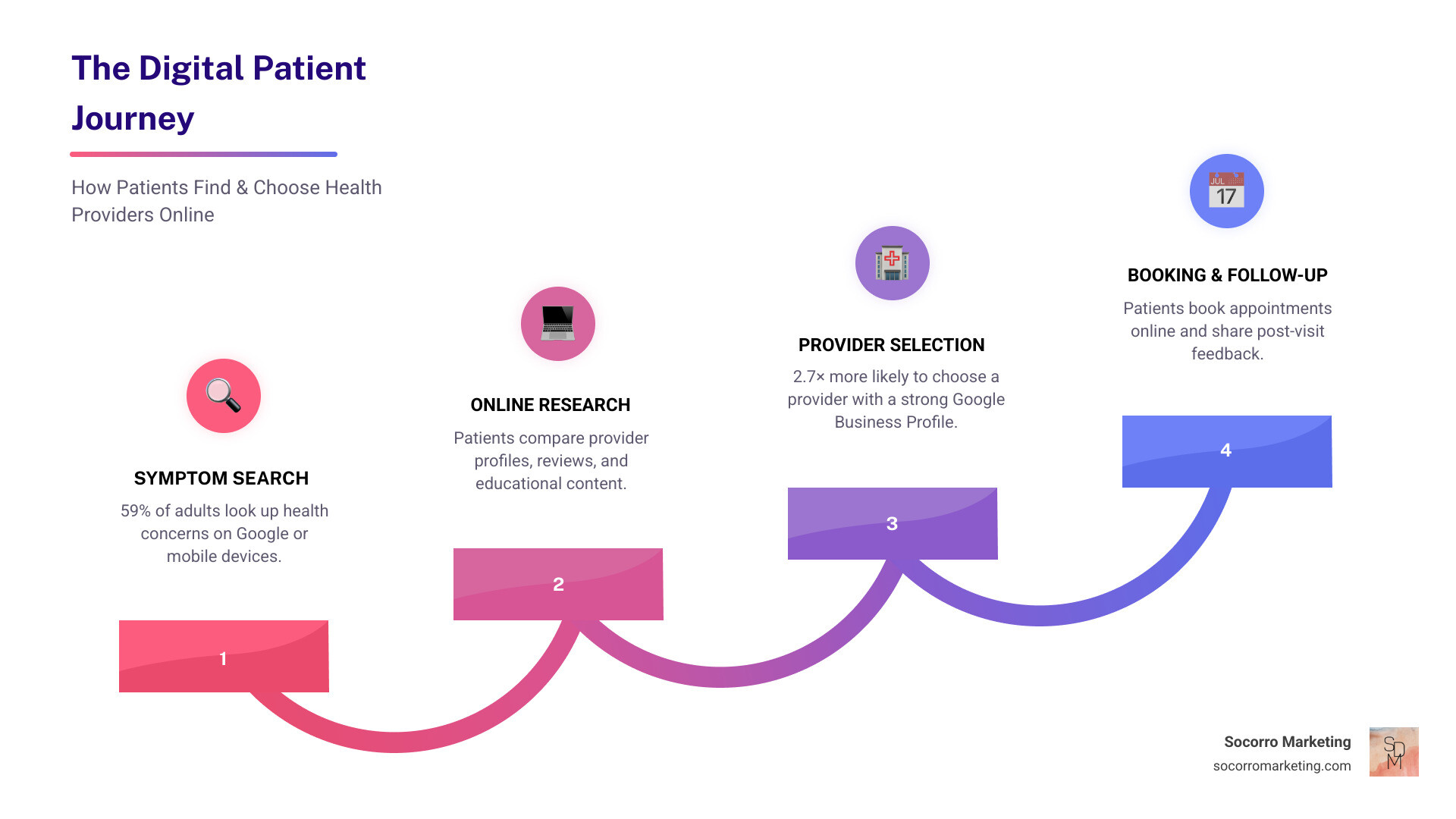
Marketing sneakers is one thing. Digital marketing for health and wellness? That’s a different world—one where trust, compassion, and privacy are a must.
Healthcare marketing follows strict regulations. Any claim you make must be scientifically backed and meet FDA or FTC standards. All data must be handled with care—HIPAA-compliant analytics and patient de-identification aren’t optional. Your website needs to meet ADA and WCAG accessibility rules, so everyone can access your info safely. And everything you say should be empathetic, inclusive, and culturally aware.
Here’s a quick comparison:
| Standard Digital Marketing | Digital Marketing for Health & Wellness |
|---|---|
| General ad claims | Claims require scientific backing, FDA/FTC compliance |
| Basic data tracking | HIPAA-compliant analytics, patient de-identification |
| Universal web standards | Must meet ADA/WCAG accessibility, privacy requirements |
| Broad messaging | Empathetic, inclusive, culturally sensitive messaging |
Regulations, claims scrutiny, and sensitive data protection make this field unique. At every step, patients need to feel safe and respected.
With digital marketing for health and wellness, the goal isn’t just to get noticed—it’s to build real trust and help people make informed choices about their well-being.
When it comes to digital marketing for health and wellness, trust isn’t just nice to have—it’s everything. If patients don’t feel safe or confident in your practice online, they’ll move on without a second thought. That’s why building trust, ensuring compliance, and showing up in the right local searches go hand in hand.
Your patients trust you with their most sensitive information—so your digital presence needs to respect that at every click. At Socorro Marketing, we put privacy first by always using HIPAA-compliant analytics tools, and making sure any data we report is fully de-identified. Our team is trained to use the latest GA4 privacy settings and secure data practices, so you can build your brand with complete peace of mind.
Want to go deeper on how we make content both engaging and secure? Check out our guide on compliance-minded content.
The magic of local SEO is how it connects your expertise with neighbors searching for help—right when they need you. Nearly half of all Google searches are local, so showing up for searches like “wellness clinic near me” can be the difference between an empty calendar and a booked schedule.
Optimizing your Google Business Profile (GBP) is a must. We make sure your name, address, and phone (NAP) are always accurate, your hours are up-to-date, and your services are clearly listed. Adding local schema markup helps search engines understand what you do and where you are. And with more patients talking to their phones (“Hey Siri, find a physical therapist nearby!”), we optimize for voice search, too.
Curious how we build strong local SEO strategies? Explore our full SEO strategy process here.
Nothing wins trust like the authentic voices of real patients. Encouraging online reviews and user-generated content (UGC) turns your happy clients into your best advocates. Did you know that websites featuring UGC see a 29% increase in web conversions? That’s a serious lift, just from letting others share their stories.
We help you gather testimonials and reviews, and we always recommend responding—both to the high-fives and to the occasional tough feedback. This shows you truly care. Featuring success stories and patient voices on your website and social channels is one of the best ways to build credibility online.
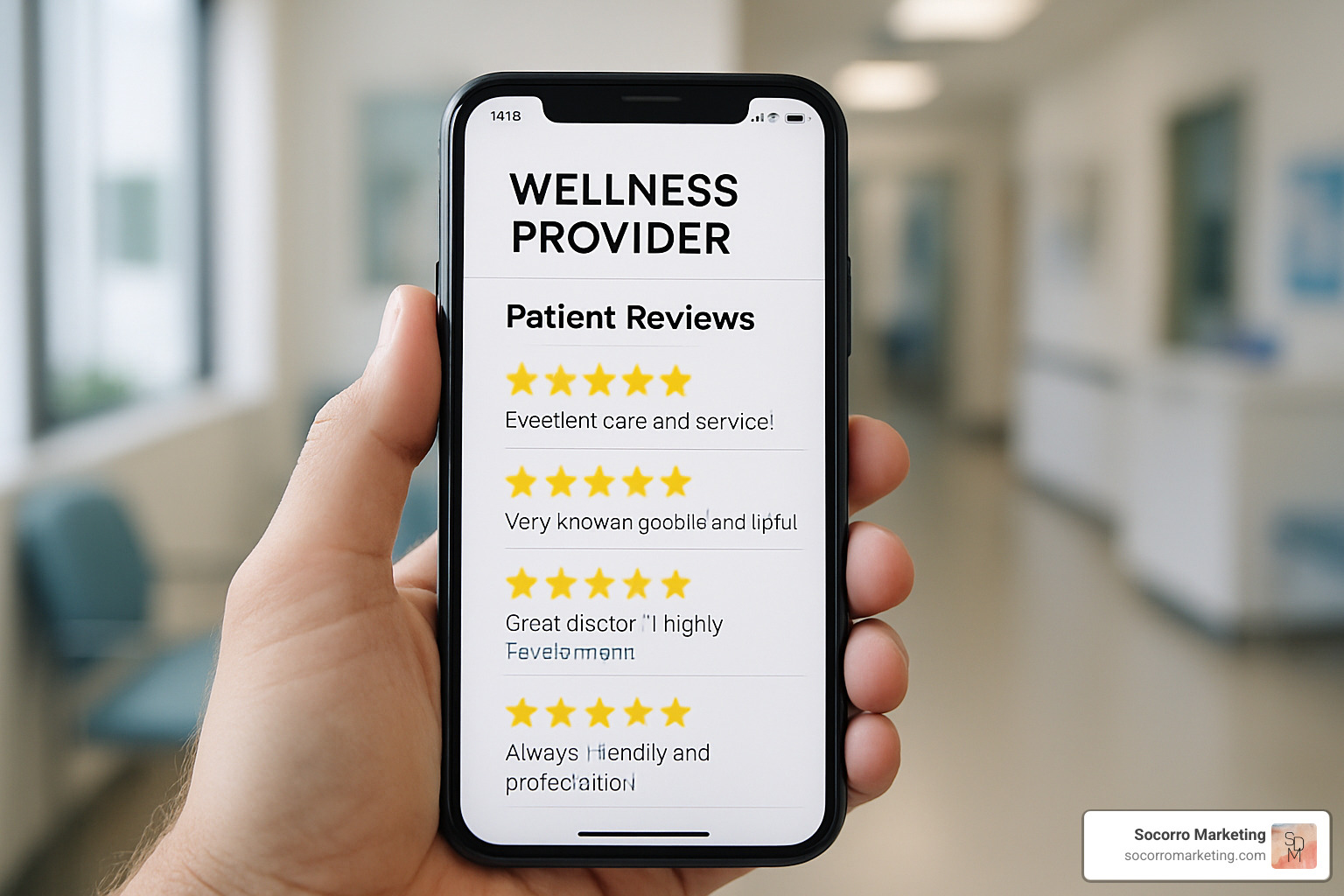
With digital marketing for health and wellness, it’s not just about reaching the top of search results—it’s about staying there with real trust, strong privacy, and a reputation that speaks for itself.
Think of digital marketing for health and wellness as your practice's digital front door. Every strategy needs to work together to create a seamless patient experience that builds trust and drives appointments.
Your content is basically your bedside manner online. Patients want to feel understood before they even walk through your door.
Educational blogs are your chance to share expertise while addressing the questions patients Google at 2 AM. When you answer "What should I expect during physical therapy?" or "How do I know if I need a chiropractor?" you're already building that patient relationship.
Explainer videos work like magic for nervous patients. Introduce your team, walk through common procedures, or explain treatment options. Here's something amazing: video on landing pages can boost conversions by up to 80%. That's because people connect with faces and voices.
Infographics turn complex medical information into something patients can actually understand and share. Think "5 Signs You Need to See a Cardiologist" or "Your Pre-Surgery Checklist."
Real patient stories showcase your outcomes in the most authentic way possible. Just make sure you have proper permission and follow HIPAA guidelines.
Learn more about medical content marketing here.
Social media is where patients seek advice, find community, and get inspired to take better care of themselves. The key is meeting them where they already are.
Choose your platforms wisely. Instagram works beautifully for wellness visuals and before-and-after changes. Facebook excels at building support groups and community discussions. TikTok and YouTube are perfect for quick educational content that makes complex topics simple.
Going live creates instant connection. Host Q&A sessions where you answer common questions, run wellness challenges, or give behind-the-scenes tours of your practice. Patients love seeing the real people behind the white coats.
Nurse influencers and clinical voices build incredible authority because they combine medical expertise with genuine empathy. When a healthcare professional shares wellness tips, people listen.
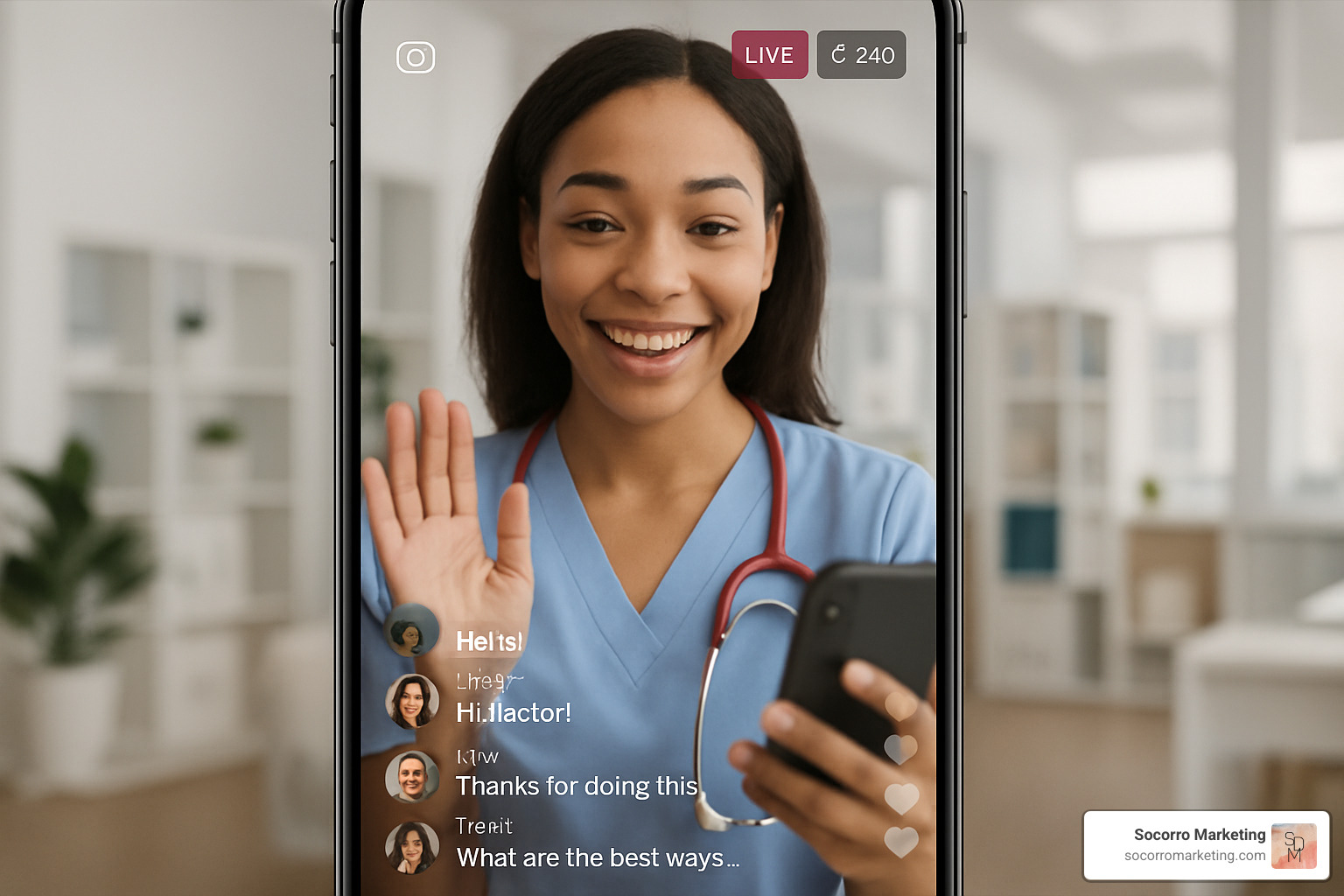
Email might seem old-school, but it's still a powerhouse for patient retention and education. The secret is making every message feel personal and valuable.
Personalized subject lines see 50% higher open rates than generic ones. Instead of "Monthly Newsletter," try "Sarah, your wellness tips for March are here."
Segmented education series work wonders for different patient journeys. New patients get welcome sequences and what-to-expect guides. Existing patients receive appointment reminders, seasonal wellness advice, and follow-up care instructions.
Smart automation handles the routine stuff so you can focus on patient care. Set up drip campaigns for post-appointment follow-ups, birthday wellness tips, or seasonal health reminders. Your patients stay engaged without you lifting a finger.
When patients need help now, paid ads put you right at the top of their search results. It's like having a billboard on the busiest digital highway.
Geo-targeted campaigns focus your budget on people in your area who can actually become patients. No point paying for clicks from three states away.
Negative keyword lists prevent wasted spending on irrelevant searches. You don't want to pay when someone searches for "free medical advice" or "DIY surgery."
Landing page optimization turns those expensive clicks into actual appointments. Streamlined booking forms, fast load times, and clear calls-to-action make the difference between a bounce and a booking.
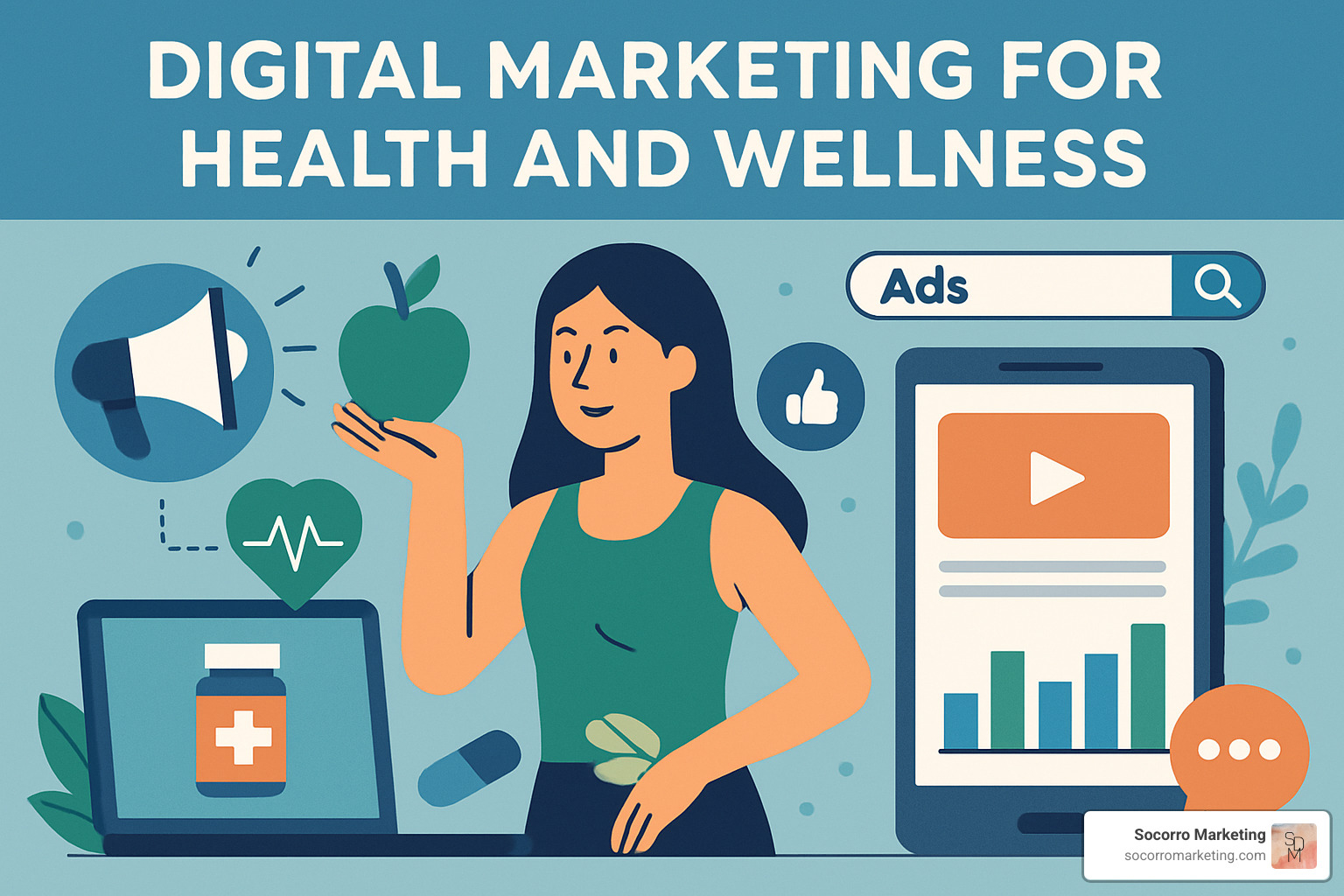
Once your foundation is solid, it's time to scale with strategies that really move the needle. The landscape is evolving fast—influencer marketing has exploded 864% since 2016, and patients are connecting with healthcare brands across more touchpoints than ever before.
Finding the right voice to represent your practice can feel overwhelming, but it doesn't have to be. The secret isn't always going big—micro-influencers with 1,000 to 100,000 followers often drive the highest engagement in wellness spaces because their audiences trust them more.
Look for creators who genuinely align with your values. A fitness influencer promoting your physical therapy practice makes sense. A lifestyle blogger pushing your pediatric clinic? Not so much. Always require clear disclosure of partnerships—it's not just ethical, it's legally required.
The beauty of digital marketing for health and wellness through influencers is the authentic connection they create. When a trusted voice shares how your treatment helped them or their family, it carries weight that traditional ads simply can't match.
Read more on influencer ROI here.
Here's the reality: your patients aren't just finding you through Google anymore. They're seeing your Instagram post, hearing your podcast ad, getting your email, and then booking an appointment. Omnichannel buyers purchase 250% more often and are 90% more likely to return because they've built trust through multiple touchpoints.
Think of it like dating—you wouldn't propose after one coffee date, right? Patients need to "meet" you across different channels before they're ready to trust you with their health. Combine SMS reminders with email nurture campaigns, social media presence with virtual events, and local SEO with targeted ads.
The magic happens when you track how these channels work together. Use foot-traffic attribution to measure how your digital campaigns drive real appointments. When you can see that your Instagram story led to a Google search that turned into a phone call, you can invest more in what's actually working.
High-ROI omnichannel combinations that consistently deliver results: Local SEO paired with Google Ads and SMS reminders for immediate bookings. Instagram content combined with influencer campaigns and virtual events for community building. Email nurture sequences linked to online webinars and patient portals for long-term retention.
Community isn't just a buzzword—it's your secret weapon for patient loyalty. When people feel connected to your brand and each other, they stick around. Host virtual wellness challenges, charity runs, or group meditation sessions that bring your patients together around shared goals.
The Köhler Effect shows us something fascinating: 95% of people complete programs when they do them with friends, compared to only 76% who go solo. This isn't just about accountability—it's about belonging.
Partner with complementary local businesses like gyms, nutritionists, or therapists. A chiropractor teaming up with a yoga studio for a "Healthy Spine Workshop" benefits everyone. Your patients get more comprehensive care, and you expand your reach without competing.

The best part? These community-focused strategies often cost less than traditional advertising while building deeper, more meaningful relationships with your patients. When someone feels like part of your wellness family, they're not just a patient—they're an advocate.
You can’t improve what you can’t see—so let’s talk about tracking and tuning your digital marketing for health and wellness strategy for steady growth.
First, set SMART goals: goals that are Specific, Measurable, Achievable, Relevant, and Time-bound. Maybe you want to increase appointment bookings by 20% this quarter, or lower your cost per lead—make it concrete so you’ll know when you’ve hit the mark.
Next, keep a close eye on the numbers. Watch key performance indicators (KPIs) like cost per lead (CPL), click-through rate (CTR), patient retention, and churn rate. These metrics are your health check for your marketing efforts. If something’s off, you’ll know where to focus your attention.
Don’t be afraid to experiment! A/B testing is your friend. Try out two different landing pages, email subject lines, or ad copy to see which one gets patients calling or clicking. Every win (and even the losses) teaches you what your patients connect with most.
Real-time dashboards help you visualize what’s working right now. You can spot trends early and adjust quickly, instead of waiting until next quarter to see results. For a deep dive into how to grow your organic reach, check out our guide to increasing organic traffic and measurement.
Behind every smooth-running campaign is the right set of tools. At Socorro Marketing, we use a HIPAA-compliant CRM to track leads and appointments safely—privacy first, always. Secure analytics platforms like Google Analytics 4 (GA4) help us keep patient data de-identified and confidential.
Heatmaps are another secret weapon—they let us actually see where visitors are clicking and what content is catching their eye. This insight means you can reorganize or highlight content that matters most.
And don’t forget marketing automation. Scheduling out emails, texts, and appointment reminders saves time and ensures no patient falls through the cracks. Automation also lets you nurture leads and follow up with patients in a way that feels personal, not robotic.
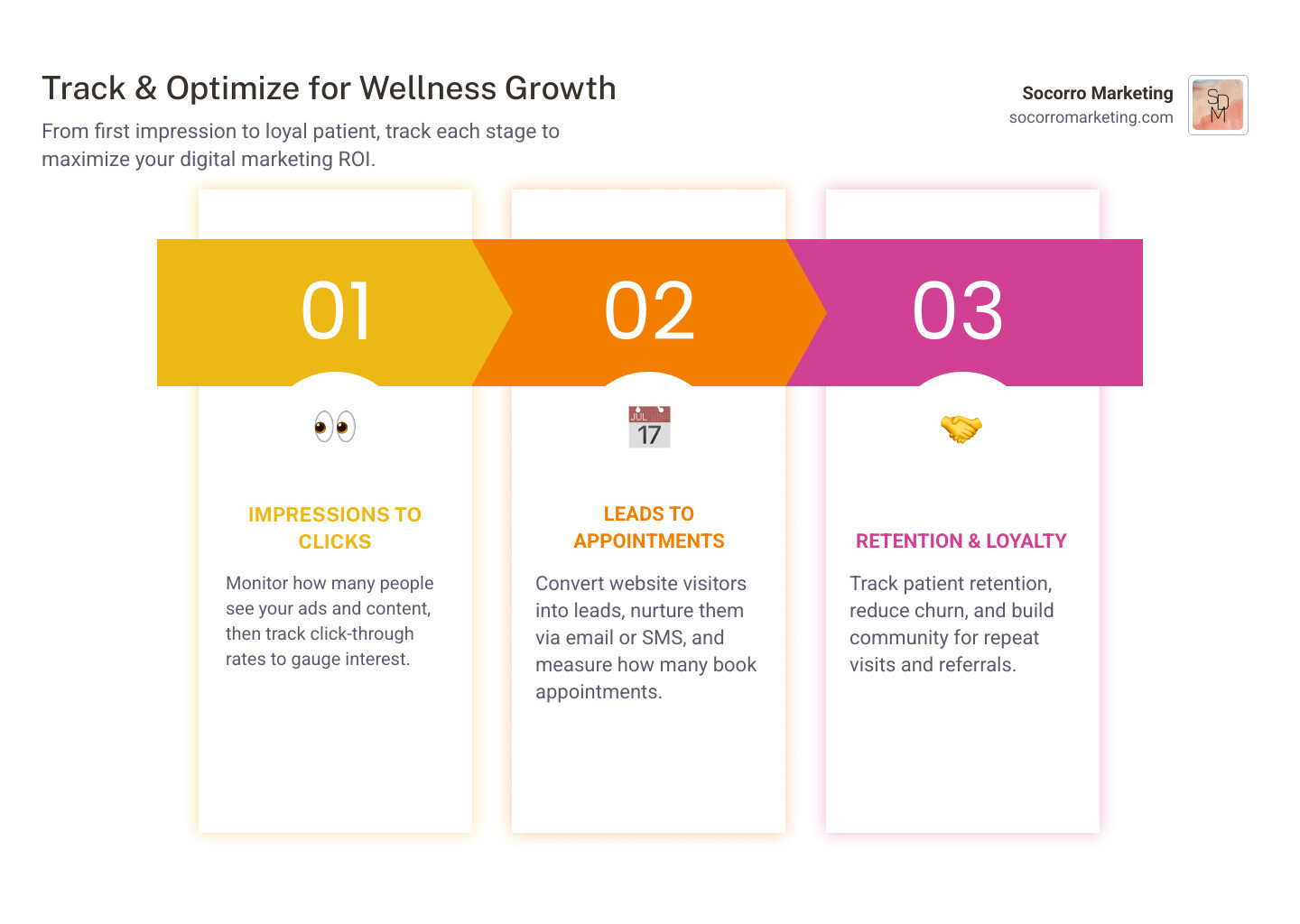
Continuous optimization isn’t just a buzzword—it’s how you move patients from first impression to loyal advocate. By tracking, testing, and refining your digital marketing for health and wellness approach, you’ll see clearer results and healthier patient relationships at every step.
When it comes to digital marketing for health and wellness, the rules of the game are a little different. Here, trust isn’t just a buzzword—it’s the bedrock of every interaction. Your patients are making important decisions about their health, so your marketing must be both sensitive and evidence-based. Every claim needs to be backed by real science, not just clever copy.
Compliance is another big difference. In healthcare, you can’t just collect data or make big promises and hope for the best. Patient privacy laws like HIPAA, accessibility requirements like ADA, and strict FDA guidelines for advertising all add extra layers of responsibility. That means every bit of patient data and every health claim needs careful handling and, sometimes, a double-check from someone who knows the medical side.
Accessibility also takes center stage. Your website and digital content need to be welcoming and usable for everyone, including people with disabilities. This isn’t just good practice—it’s the law, and it’s the right thing to do.
If you’re looking for quick wins with digital marketing for health and wellness, a few channels stand out. PPC (Paid Search) is a great way to get your name in front of local patients who are actively searching for services like yours. You’ll see results fast, especially if you use smart targeting.
Local SEO is another must for small healthcare practices. With a well-optimized Google Business Profile, you can show up in those all-important “near me” searches and become a top pick for nearby patients.
Don’t overlook email marketing either—it’s a trusty workhorse. It’s affordable, gets results fast, and keeps you connected with both new and existing patients. Plus, with a little personalization, your emails are much more likely to get opened.
Getting started with digital marketing for health and wellness doesn’t have to feel overwhelming. Here’s a simple roadmap:
First, define your goals. Do you want to bring in new patients, book more procedures, or just build brand awareness? Knowing where you’re headed helps you measure what matters.
Next, audit your website. Is it mobile-friendly? Does it load quickly? Is it easy for someone (even your grandma) to use? Addressing these basics helps you make a great first impression.
Finally, set up your Google Business Profile. Make sure your information—like hours, phone number, and services—is accurate. Encourage patients to leave reviews. This builds instant trust and helps you stand out to people searching in your area.
If you want extra guidance or a deeper dive, you can always explore our digital marketing services or check out our resources on compliance-minded content and SEO strategy. We’re here to help you every step of the way.
The digital health landscape has fundamentally changed how patients find and choose their healthcare providers. Digital marketing for health and wellness isn't just a nice-to-have anymore—it's become the bridge between your expertise and the patients who need you most.
Throughout this guide, we've explored how the unique challenges of healthcare marketing require specialized approaches. From HIPAA compliance to trust-building content, from local SEO to influencer partnerships, every strategy needs to balance growth with the empathy and accuracy that healthcare demands.
The numbers don't lie: with 300,000 health searches happening every minute and the digital health market projected to exceed $1.96 trillion by 2030, the practices that thrive will be those that meet patients where they are—online, mobile-first, and searching for answers.
But here's what makes all the difference: combining clinical insight with marketing expertise. Understanding both the patient journey and the provider perspective creates campaigns that truly resonate. It's not enough to know how to run Google Ads—you need to understand what concerns keep patients up at night and how to address them with genuine care.
At Socorro Marketing, our nurse-managed approach brings exactly this combination to the table. We've spent years helping health and wellness businesses across Golden, CO, Utah, Arizona, New Mexico, and Colorado build digital strategies that are both compliant and compelling. Our team understands medical terminology, patient psychology, and the regulatory landscape because we've lived it from both sides.
The future of healthcare marketing is omnichannel, data-driven, and deeply personal. Whether you're just starting your digital journey or looking to optimize existing campaigns, the key is finding partners who understand that behind every click is a person seeking help, hope, or healing.
Ready to transform your digital presence into a patient magnet? Learn more about our digital marketing services and find how clinical expertise and marketing savvy can work together to grow your practice with integrity and impact.
